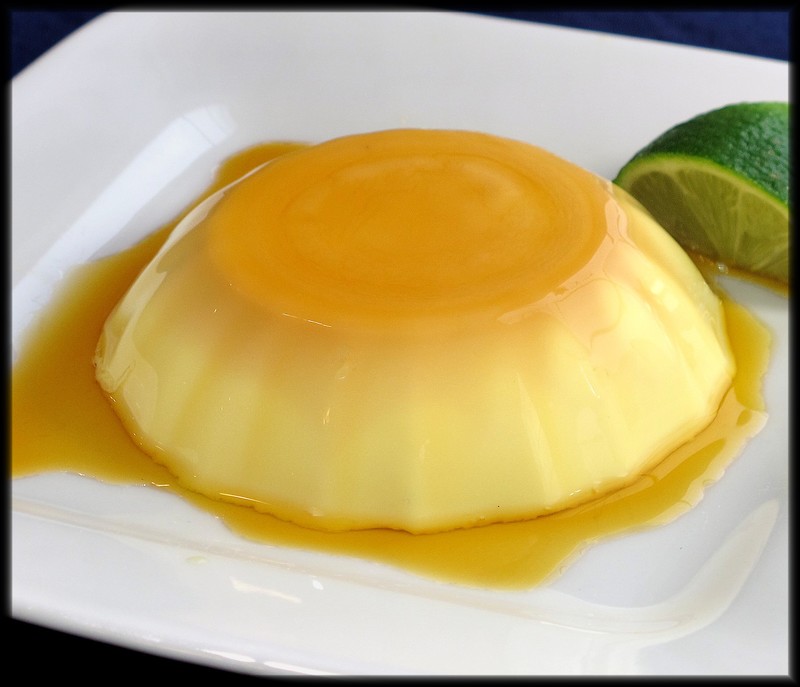Earlier this week, we enjoyed a traditional Cinco de Mayo dessert - flan, a silky-soft pudding topped with caramel. Of course, like almost everything we find on a menu, we started wondering about the origins of pudding, in all its varieties.
There are two types of pudding; one began as a savory dish and the other has always been egg-based, each with a venerable history. Early versions of savory puddings were more like what we recognize today as sausage. British culinary tradition includes black (or blood) and white puddings, both of which were meat-based. And who hasn’t heard of the Scottish pudding known as haggis - a mixture of oatmeal and organ meats cooked in a sheep’s or lamb’s stomach.
The nursery rhyme dish of pease porridge is a savory pudding made from roasted yellow field peas ground into flour, then boiled with bacon. This highly nutritious gluten-free flour can be purchased from purveyors in the United Kingdom; I’ve not seen it for sale in this country.
Over the centuries, British puddings remained solid, but shed meat as an ingredient. Yuletide plum puddings have the consistency of a dense cake and originally included suet (rendered meat fat). Modern recipes typically omit the suet and create a rich texture with dried fruits and a brandy soak.
Food historians generally agree that the origins of the egg-based sweet puddings known as custard probably date to the Middle Ages. Basic custard is a cooked mixture of eggs and milk (or cream). Much like the sausage puddings, these dishes could also include solids, such as meat, fish, vegetables or fruit. Over time, the culinary world developed a precise set of terminology for each preparation, based on the specific ingredients.
We’ll stick with custard for this discussion, and two of the most familiar custard desserts are flan and crème brûlée. Both begin with a vanilla-flavored custard partnered with caramel topping, but there are few subtle differences between the two. Crème brûlée (which translates to burnt cream) has more cream and less egg, while flan is eggier with less cream.
When assembling a flan, caramel is poured into the bottom of ramekins before the custard is added. These are baked in a water bath to keep the custard from separating. To serve, the ramekins are inverted to release the flan and the caramel now sits on top and drizzles down the sides (see photo).
Crème brûlée is whisked together and baked in ramekins in a water bath, only without the caramel. To create the crunchy crust of golden sweetness, sugar is sprinkled on top and caramelized with a kitchen torch just before serving. Both of these custard desserts can be enhanced with flavorings such as lemon, orange, cinnamon and vanilla, as in the recipes below.
In keeping with the origins of pudding as a dense dish, I’ve also included a recipe for rice pudding. You can use any type of white rice to make this comfort food standby; brown rice can be a bit toothy. Basmati or Jasmine rice will add a unique flavor and lovely texture. And, no matter which rice you use, please don’t add raisins.
Flan
1/3 C sugar
2 C milk
1-inch strip of lemon peel
1 cinnamon stick
6 eggs
1/3 C sugar
1 t vanilla
Preheat oven to 300 F. Place 1/3 C sugar in a small skillet. Cook over medium, stirring constantly, until sugar is melted and golden. Divide the caramelized sugar evenly to coat the bottom of 6 half-cup ramekins; set aside. Place milk, lemon peel and cinnamon stick in a saucepan. Bring to a boil over medium, then immediately remove from heat; discard lemon and cinnamon stick. In a mixing bowl, lightly beat eggs until smooth. Whisk in sugar and vanilla. Gradually add milk, whisking until smooth. Pour custard through a mesh sieve to strain out any solids, then pour into ramekins. Place ramekins in a deep baking pan and fill pan with hot water to a depth of two inches. Bake for 1 hour. Remove custards from the pan of water and chill in the refrigerator. To serve, invert ramekins onto a serving plate. Yield: 6 servings.
Crème Brûlée
1 egg
4 egg yolks
1/2 C sugar
1 C heavy cream
2 C light cream
1 t vanilla
1 T Grand Marnier (optional)
1 t orange zest
6 T sugar
Preheat oven to 300 F. Combine the egg, egg yolks, and 1/2 C sugar in a large mixing bowl. Whisk until the sugar is completely dissolved and mixture is silken; set aside. In a saucepan, scald cream until very hot; do not boil. Slowly add cream to the eggs, whisking constantly until combined. Using a spoon, skim off any foam that has formed. Whisk in the vanilla and pour custard into 6 half-cup ramekins. Place ramekins in a deep baking pan and fill pan with hot water halfway up the sides of the ramekins, taking care not to splash any water. Bake until the custard is set when gently shaken, about 35 minutes. Remove the ramekins from the pan and cool; refrigerate until firm. To serve, sprinkle 1 T sugar over each ramekin; heat with a kitchen torch until sugar caramelizes. Yield: 6 servings.
Rice Pudding
2 1/2 C milk
1/3 C Basmati rice
pinch salt
1/4 C sugar
1 t vanilla
1/4 t cinnamon
Combine milk, rice and salt in a heavy saucepan. Bring to a boil on high; reduce heat to low and simmer, stirring frequently, until rice is tender, about 20 minutes. Remove from heat and whisk in sugar, vanilla and cinnamon. Return to low heat and cook another 5 minutes. Spoon pudding into serving bowls and cover with plastic wrap, making sure the wrap touches the surface of the pudding. Refrigerate until chilled, about 2 hours.






















































